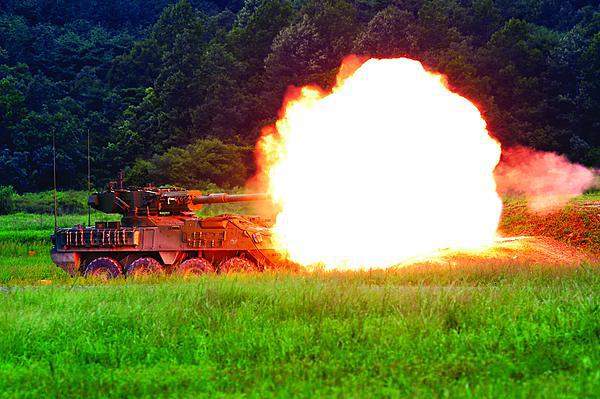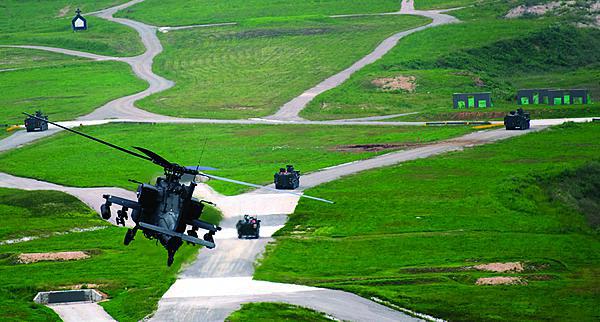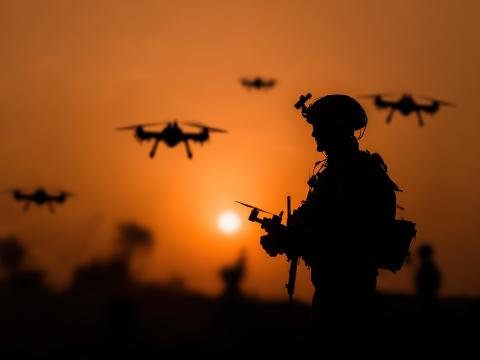Korea Exercise Changes the Game
An unprecedented choice allows soldiers to use communications and intelligence assets in more meaningful ways.
Military operational decisions are moving further down the chain of the command, and a group of Stryker soldiers has taken a large step toward improving the training small units receive. Troops with this battalion had a chance to practice with capabilities never before available to them in an environment that simulates combat better than any facility they have at home. The results are new levels of preparation and confidence for whatever challenges they may be called on to handle next.
Home based in Hawaii, the 1st Battalion, 27th Infantry Regiment, 2nd Stryker Brigade Combat Team, 25th Infantry Division traveled to Korea to conduct the training event Wolfhound Maul. The unit is nicknamed the Wolfhounds. Contained within that effort was a smaller combined arms live fire exercise (CALFEX) that gave the unit’s three subordinate companies a chance to run full-spectrum operations with new assets in stressful surroundings. Maj. Christopher Choi, USA, operations officer for the battalion, says that as his team searched for the best resources to conduct the training it wanted to provide, it realized Korea offered benefits not available in Hawaii. After a careful cost-benefit analysis, decision makers chose to approve the travel to the Korean peninsula. Almost the entire battalion made the trip, with its companies experiencing the CALFEX training one at a time over a period of a month.
The location change introduced a variety of advantages, including the opportunity to work with additional partners and to operate in a larger area, which allowed for exercising more technologies. A key component to overall success in terms of command, control, communications, computers, intelligence, surveillance and reconnaissance (C4ISR) was the integration of tactical satellite and high-frequency radio communication during air assaults. “Each platoon executed three air assaults, which presented new challenges foreign to a Stryker battalion,” Maj. Choi says.
In a CALFEX event, the platoon leader is the primary training audience, and the recent exercise helped those soldiers learn how to manage all the C4ISR capabilities their Strykers offer. They trained on how to deconflict systems and what risks they assume when turning on and off the various enablers at their disposal. During the execution of each air assault, soldiers were trained to communicate with UH-60 Blackhawk rotary-wing aircraft, the platoon leader on the ground, sister units and the battalion tactical operations center. These various elements spanned distances greater than 30 kilometers, Maj. Choi explains. He adds that long-range communications were critical to enabling command and control at three locations operating simultaneously at significant distances from one another.
Running long-range communications was a task frequently exercised throughout Wolfhound Maul. Soldiers had to contend with mountainous terrain to keep information-sharing channels operational. Unit members who trained previously as subject matter experts showcased successful integration of high-frequency radios to support missions, helping overcome the natural desire to operate with unsecure radio equipment. At the company level, soldiers worked on integrating all the assets they have at their disposal. One of these is the Raven unmanned aerial vehicle the companies employ in many of their real-world operations. Capt. Jon Peterson, USA, commander of the Bravo Company that falls under the battalion, explains that traveling to Korea enabled soldiers to use the Ravens, unlike in Hawaii, where they face restricted airspace. The difference meant that troops and leaders had their first opportunity to train with the vehicles in such a realistic fashion. “Korea provided soldiers and leaders with training opportunities that are extremely difficult to coordinate for and employ in Hawaii,” the captain states. “Specifically, the integration of ISR [in the form of the Raven] allowed for real-time updates on the training area and provided leadership with accurate intelligence regarding enemy activity.”
Another major technology piece used during the exercise was the One System Remote Video Terminal that displays information received from the Raven inside the Stryker. Capt. Peterson says the CALFEX was the first opportunity for battalion soldiers to use the two capabilities together, adding that the equipment soldiers implemented under live fire in the exercise was unique, paving the way for more effective results in Afghanistan or on another battlefield. “Having the opportunity to do that in Korea prior to any type of deployment absolutely set them up for success,” the captain says. The lessons learned also helped the battalion refine standard operating procedures.
By transferring the training to Southeast Asia, the unit was able to reach all the goals it set to integrate close combat aviation, artillery mortar, Republic of Korea field artillery forces and other U.S. Army units, including two engineering units. Capt. Peterson says the opportunity to work with soldiers in other formations and to practice full-spectrum operations allowed his troops to build capabilities that will make them more effective in any contingency. The soldiers not only trained with live fire, but they also were able to exercise in an urban environment not available in Hawaii.
The goal for Maj. Choi and other planners of the exercise was to simulate combat as closely as possible without real enemies or compromising safety. They incorporated serious ground-based firepower in addition to the munitions provided by fixed- and rotary-wing aircraft platforms. Examples include Stryker-mounted .50-caliber machine guns, MK-19 40-millimeter grenade launchers, rockets and other mobile gun systems. The various weapons were fired at pop-up targets within close range to mounted and dismounted soldiers maneuvering through the tight training lanes as they tried to suppress enemies. Maj. Choi says the unit pushed the outside of the envelope in terms of giving soldiers a taste of real combat while keeping them safe. Having fixed-wing-aircraft, rotary-wing aircraft and artillery support at the same time is unusual, even in combat situations. By exercising with them all, platoon leaders could plan and execute on a level unprecedented in the officers’ experiences. Maj. Choi emphasizes that simulating war at such a realistic level is impossible except for at a few locations in the Army.
Two big features from Wolfhound Maul stand out for the major, the first of which is thinking outside of the box. He explains that when the Army considers platoon-level training, it focuses on the home-station level. Through lengthy research and analysis, planners of the Korea event were able to find a location and situation that provided exponentially better training. The second big feature is teamwork. “The teamwork was just ridiculous,” Maj. Choi states. “We got more than we asked for ... No matter where you are, it’s still one team, one fight.” His unit worked closely with U.S. Forces Korea to prepare the necessary resources along with other partners who played roles in the exercise. He states that no one at any point had directives to assist with the effort, but planners felt that if they received even half of what they wanted, the experience still would be better than what they could create in Hawaii.
The CALFEX gave participants a chance to see their own accuracy and that of their compatriots while building trust among them. The event focused on lethality and equipping troops with the fundamentals to fight anywhere regardless of the theater, Maj. Choi explains. However, firepower alone does not ensure victory in every location. Capt. Peterson says that in the Middle East, understanding of environment, populace and culture plays a key role as well. Now that leaders have completed the CALFEX, they are educating troops on the differences between the United States and Afghanistan to help their soldiers realize additional, less-kinetic skills to make them effective in battle.
Though the battalion is stationed in the Asia-Pacific region and conducted the training there, its most recent deployment was to Iraq. Capt. Peterson says the Stryker is a flexible platform that can operate in most locations with the proper support. He touts the 225th Brigade Support Battalion that rectified equipment problems as well as provided other necessary assistance that enabled mission capability during Wolfhound Maul. “As long as we have that support, it allows us to be effective in any environment,” the captain states.
There are no plans for the 1st Battalion, 27th Infantry Division to deploy to Korea, but the training helped establish good relationships between U.S. and Korean units. Just as the battalion is looking into the softer side of battles in the Middle East, commanders and soldiers have better understanding of Korea’s terrain and culture at the ground tactical level. This knowledge adds to their combat effectiveness if they are required to operate in the Far Eastern nation.
Platoon-level training is now complete for the battalion’s current cycle, and planners have moved on to brigade-level events. But Maj. Choi says that in the future, he definitely will look forward to planning an event similar to Wolfhound Maul and its CALFEX if the opportunity arises.






Comments